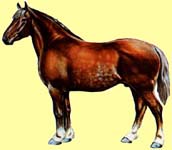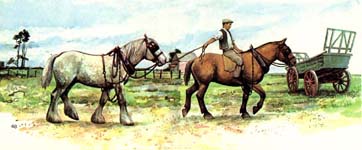|
|
The Suffolk Punch |
|
|
|
The Suffolk Punch |
|
 Distributed throughout Europe today, the Suffolk Punch is a horse of the brachymorphic type originating from Great Britain. Native of the English county of Suffolk, this horse is certainly one of the descendants of the
Great Horse. The Suffolk breed dates back to 1506, created with contributions from the
Norfolk Trotter and the Norfolk Cob, with a possible later influence by the
English Thoroughbred. A small trotting stallion named Blakes Farmer (1760) seems to be responsible for the chestnut colored coat. Blakes Farmer handed down his chestnut coloring to all of his descendants. Other contributions probably came from the heavier
Flanders mares imported from Holland. Both the trotting roadsters and the Flanders mares possessed much the same coloring which is now regarded as a characteristic of the Suffolk, and the Flanders horses were robust trotters.
Distributed throughout Europe today, the Suffolk Punch is a horse of the brachymorphic type originating from Great Britain. Native of the English county of Suffolk, this horse is certainly one of the descendants of the
Great Horse. The Suffolk breed dates back to 1506, created with contributions from the
Norfolk Trotter and the Norfolk Cob, with a possible later influence by the
English Thoroughbred. A small trotting stallion named Blakes Farmer (1760) seems to be responsible for the chestnut colored coat. Blakes Farmer handed down his chestnut coloring to all of his descendants. Other contributions probably came from the heavier
Flanders mares imported from Holland. Both the trotting roadsters and the Flanders mares possessed much the same coloring which is now regarded as a characteristic of the Suffolk, and the Flanders horses were robust trotters.
The particular build of this breed is implied in the epithet "Punch," and has been described as "barrel-shaped with not much daylight under." The English dictionary defines Punch as a variety of English horse, short-legged and barrel-bodied, "a short, fat fellow," a description which fits its subject exactly. The Suffolk has clean feet and no feathering. It is always "chesnut" in color, the spelling traditional in Britain when applied to this breed, and it is always spelled that way in the breed records. Its even color comes in seven shades - brown-black, dull-dark, light-mealy, red, golden, lemon and bright "chesnut."
The oldest English breed of heavy horse, it was recorded by the name Suffolk as early as the 16th Century. During the 18th Century, more accurate descriptions were made as to the horse's aesthetic features, though not very complimentary. It was described as having a big head and a clumsy looking body and legs. This description is far from the Suffolk of today, with it becoming a horse with a noble head and a shapely body. Established early in the development was the Suffolk's chestnut color, which was once called sorrel.
The Suffolk's origin is a question not easily answered. There has been an assumption that it may in part have descended from Nordic horses, due to a resemblance to the heavy horses of Scandinavia. It is clear that the original pony population had an influence on the Suffolk. This is still reflected in some aspects of its anatomy and long life. Suffolks have been known to live thirty years or more without exception, seemingly confirming a belief that country living is healthy, adding years to ones life.
Confined to its home region of East Anglia during most of its history, the Suffolk has never had quite the same appeal to overseas buyers as others. Still some horses came to the United States, where there is a loyal and devoted contingent of Suffolk breeders. Already having their own lighter breeds, most breeders in other countries were interested in importing the heaviest and tallest horses. It also was considered much too ordinary in appearance to be exciting.
Some weighing around 1600 pounds, the Suffolk's strengthen and endurance makes it ideally suitable to agricultural tasks, for which it is primarily used. It has great width front and aft and short legs which give it a low point of draft and enormous pulling power. Also Suffolks are noted for their excellent feet or "bottom." Once the opposite were true, thus special classifications were made to offer prizes for "best feet." This caused efforts to breed for this classification and they were successful that the feet the Suffolks of today are considered the best among the heavy breeds. A test was given at Suffolk fairs where the Punches are offered for sale. The horse was hitched to a heavy, fallen tree, and though the tree didn't have to be moved, the horse had to get right down on his knees to pass the test. This is known as the typical, Suffolk, drawing attitude.
The life work of one man, Herman Biddell (born in 1832), is responsible for much of what is known about the more recent history of the Suffolk Punch. Biddell was a farmer and breeder who devoted a great deal of his time to research of various lines and strains. He traveled throughout the countryside visiting numerous farms. Biddell was commissioned to compile the first studbook after the Suffolk Horse Society was founded in 1877. A surprising fact that was brought to light by his work, was that most of the Suffolk lines led back to a single horse - "Thomas Crisp's Horse of Uffort" (Orford), foaled in 1768. He was a "chesnut" horse, as are all Suffolks, and while this Suffolk was known as having a shapely head, it seems that nobody bothered to give it a proper Christian name. Since every purebred Suffolk today is directly related to this horse, it must have had everything that mattered.
The Suffolk Punch stands 15.3 to 16.2 hands high and weighs 1,980 to 2,200 pounds. The coat color is exclusively chestnut, without white markings. It has a short and handsome head with a straight profile, broad forehead and expressive eyes. Its neck is short and broad at the base, muscular and arched. Its withers are low and broad, and the back is short, wide and straight. It has a broad, muscular croup and full and powerful loins. The wide chest is deep and muscular, and the long, sloping shoulder is well-muscled. The rather short legs are strong, well-muscled and almost without feathering. The leg joints are broad, the cannons and pasterns short, and the feet sound and well-formed.
 This is a strong and frugal horse that is early-maturing and long-lived. The Suffolk is a quiet and sociable horse used for heavy draft. Developed as a farm horse, the breed is now of international importance. In days gone by, the Suffolk was used for drawing the brewer's drays and omnibuses, and it was also well-suited to do farm work and draw heavy artillery in times of war. The economical Suffolk has unquestionable stamina and power, yet it thrives on less field than is needed by other heavy horses. On a typical East Anglian farm, a Suffolk is fed at 4:30 a.m., goes to the field two hours later. With short rests, the Suffolk can work until 2:30 p.m., while other heavy breeds would have to stop at mid-morning for another feed with additional time allowed for digestion. The enormous pulling power of the Suffolk once created a demand for the horse for heavy draft work in towns and cities.
This is a strong and frugal horse that is early-maturing and long-lived. The Suffolk is a quiet and sociable horse used for heavy draft. Developed as a farm horse, the breed is now of international importance. In days gone by, the Suffolk was used for drawing the brewer's drays and omnibuses, and it was also well-suited to do farm work and draw heavy artillery in times of war. The economical Suffolk has unquestionable stamina and power, yet it thrives on less field than is needed by other heavy horses. On a typical East Anglian farm, a Suffolk is fed at 4:30 a.m., goes to the field two hours later. With short rests, the Suffolk can work until 2:30 p.m., while other heavy breeds would have to stop at mid-morning for another feed with additional time allowed for digestion. The enormous pulling power of the Suffolk once created a demand for the horse for heavy draft work in towns and cities.
For more information on Suffolk Punch draft horses visit:

|
© 1997-2007
NW Breyer Horse Club & Refiner of Gold Creations Equinealities in place since 1997, Section in place 2001, Updated 3/13/2007 |



|
| ||

|
|||||